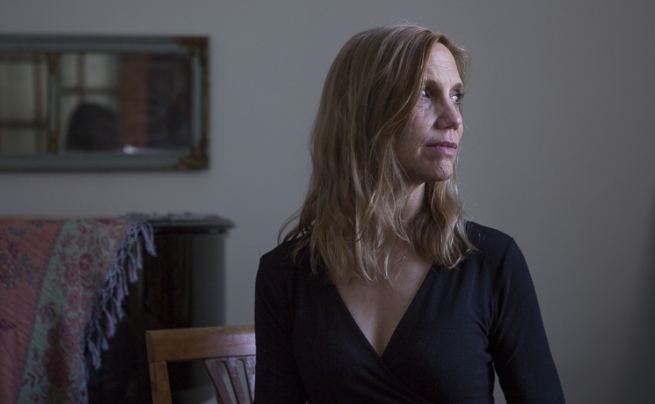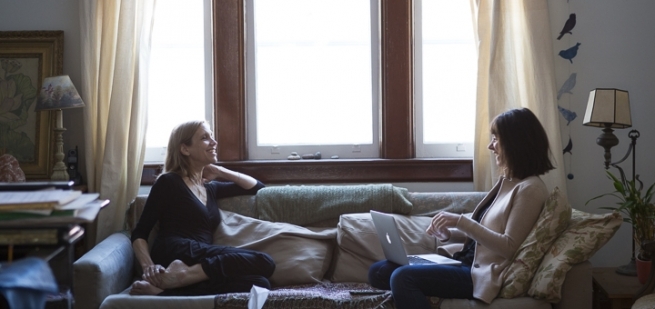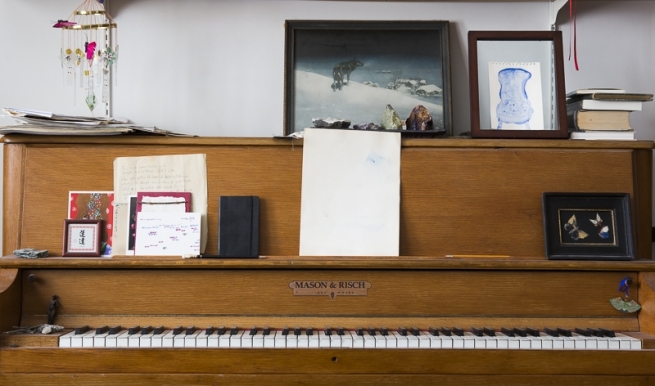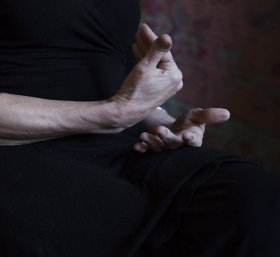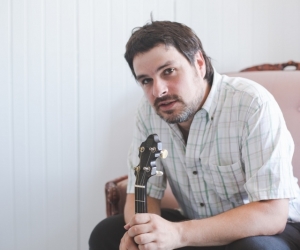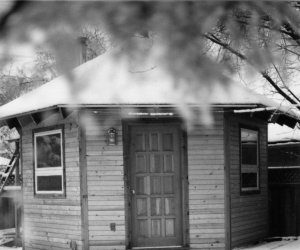It’s 2004. I am taking my first composition course at Mount Allison University. I have recently become enamoured of new music and am catching up on a long list of listening in the basement of the Alfred Whitehead Memorial Music Library. I come across Memory Forms (2001), a serene-looking disc with a still-life pear standing out from a dark background. I put on my giant headphones, plug them into the ’90s-period CD player, insert the disc, and hit play on Moi Qui Tremblais.
Slightly asymmetrical, softly repeated piano chords fill the space, the shadow of an inner melody being picked out. While the piano chords slowly spin to reveal their different angles, a velvety hybrid sound of bass drum and cymbal counters the piano effects. A single violin note emerges, incredibly quiet but persistent, changing to a harmonic shimmer, much as the wind shifts. The music sways within narrow dimensions that pretend to be quite contained, and yet the drama created by these irregular shifts has the thrill and unpredictability of waves hitting the sand.
Who is Linda Catlin Smith? I wonder.
When someone is asked to describe Linda Catlin Smith’s music, they often pause to search for just the right word. Then the words come flowing—elegant, unadorned, painterly, poetic, warm, unflinching, enchanting. It’s challenging to put into words the intense yet frangible line connecting her music to the listener. There’s a feeling that by describing it out loud, her music could disappear into thin air.
Earlier this year, on a cold January afternoon, I am sitting in the spacious first-floor living room of Smith’s beautiful home in Toronto’s Queen West area neighbourhood. I have been here many times as her student, so I feel at home in this room, which is filled with original artwork, vintage furniture, and her grand piano. As we catch up, we dance from topic to topic; we talk about her late mother’s converted garage–living room, we laugh about avoiding the reading of program notes at concerts, we marvel at how people in Winnipeg make it out to concerts in the dead of winter.
Raised in New York, Smith was deeply immersed in music as a young child. She fooled around on the piano—which has remained essential to her composition process—and had a record player in her bedroom. “I loved the piano. I loved the sound it made, so I was wrapped up in playing around at the piano from pretty early on.” At bedtime, Smith’s mother would put the needle down on an LP, say goodnight, turn off the light, and leave the door open a crack: “It’s very powerful to listen to music in the dark. There’s just a little bit of light—and music.” She mentions some of her favourite works from that early time—Paul Hindemith’s Mathis der Maler, Bela Bartok’s Contrasts, Billie Holiday’s “Yesterdays,” Charlie Christian’s “Stardust”—and when she mentions Igor Stravinsky’s Rite of Spring, I make a crack about being a small, wide-eyed child trying to fall asleep to the accented rhythms of Dances of the Young Girls, and she dissolves into laughter.
Smith went to Elizabeth Seeger High School, an alternative high school with fifty students, and began taking one-on-one composition lessons with a young Allen Shawn, now an American composer, educator, and author of note. He was the first person to take her composing seriously, and to see her as an artist, she tells me. Working at the piano, finding and fooling around with material, was such a big part of her, and Shawn recognized that: “It was like being
seen,” she explains. “I felt quite invisible when I was fifteen, sixteen, seventeen, and I really felt like he cared. He really has no idea how much that helped. I think I was on the verge of being quite lost. I was a fairly depressed teenager.”
“I felt from the very first encounter that she was a composer,” recalls Shawn. “The connection between her and the notes she put down was so deep. That’s something you simply can’t teach. It was a beautiful thing. She meant what she wrote, and she heard it and she felt it, and she needed it. That connection was the manifestation of a part of her that was essential, that she had to put on paper; and to me, that’s a composer.
“She was like a cat that senses a car from a long distance away, just in a constant state of alertness to sound and music of all kinds.”
After studying at SUNY Stony Brook University in New York, Smith attended the Master of Music graduate program at the University of Victoria and began immersing herself in the works of John Cage, Steve Reich, György Ligeti, and Morton Feldman. The university’s music library had an incredibly robust collection of contemporary music, and she could take out up to six records a day. “You could always have forty-two records in your possession. I just wore out some of those records.” She remembers listening to Sonatas and Interludes: “Those Cage recordings felt like a music I could understand, whereas the Elliot Carter I had heard didn’t feel like I could ever understand, but I still liked it.”
Her fellow students at the University of Victoria—Christopher Butterfield, Anthony Genge, Rodney Sharman—were significantly influential on her creative thinking, as well. “Their work, and the way they were thinking about music . . .” she reminisces. “We were spending a lot of time talking about art.” Around this time, Butterfield was starting a band in Toronto, and her boyfriend (now husband), percussionist Rick Sacks, moved to Toronto to join the art-rock band KLO. “So basically, I came to Toronto for love,” Smith says. The couple had planned to move back to New York, but they got involved pretty quickly in Toronto. “And then we were just busy, and it felt like there was more opportunity here. I ended up really liking the artistic milieu of Toronto. And you kind of go where you have work, too.”
In 1987 she was asked to join the board of the contemporary music ensemble Arraymusic, and then a year later became its artistic director. She started Arraymusic’s Young Composers Workshop, which is still running today. Composer John Mark Sherlock found his experience at the 1994 workshop to be “somewhat of a crucible and generally quite jarring. It was my first time working with professional musicians and I found their brutal honesty, well, brutal. Smith was very sensitive to this disconnect and was able to act as a filter. Her way of hearing what you were doing or trying to do and giving you permission to trust your own instinct and embrace your uniqueness was just the right salve.”
It’s 2011. I enter Linda Catlin Smith’s house for my lesson, walk up the creaky hardwood stairs and into her second-floor studio, which is flooded with light from the huge window which overlooks Trinity Bellwoods Park. Books are piled up everywhere, in bookcases, on the floor, on the desk. A disarray of CDs is strewn across various surfaces, as are bells, small rocks, a tiny bottle of nail polish. Her walnut apartment-size piano is on top of a cozy Persian rug, and there are framed prints around the room, some hung, some casually leaning up against the wall. I take my usual spot on the piano bench, Smith is in her desk chair, my score is on a chair between us.
The lessons are part friendship, part class, part therapy. I tell her my frustrating thoughts on the piece I’m writing, unscrambling my worries and priorities as I talk about the rhythm being too straight at this part, the fine-tuning of the tone of the text, or the overall effect that I’m going for—and not going for. She furrows her brow and says something like, “What if instead of building up from a kernel of material you started where you want to end up and work backwards?”
And then all of a sudden, I feel as if the clouds have shifted; the light in the room feels completely different.
In 1999, at the invitation of composer Peter Hatch, Linda Catlin Smith started teaching composition at Wilfrid Laurier University in Waterloo, Ontario, where she still teaches today. Composer Julia Mermelstein, who recently studied with Smith says, “She would mention a simple analogy of comparing a certain sound to a type of fabric or paint texture, helping to contextualize and distill more abstract ideas. I learned so much about timing and space and ways of sitting with my musical material to feel how it can intuitively evolve, especially allowing for and being okay with more space if it needs it.”
The discipline of listening is deeply important to Smith. It is a composer’s duty, she says, to understand as much as possible about what’s being written today “so that we [as composers] are in context with our colleagues in some way, and learning from all the work that’s come [before] us.” She is as intrigued by things she doesn’t like as she is by those she does. “In every listening experience, I try to look for the one thing that sparkles for me; or I learn from that piece that I didn’t like. I’m always invested as a listener. I’ll give it my 100 per cent because there’s something in there for me, and then I take that thing—I’m really a packrat, a scavenger, when it comes to listening. I’m looking for not just ideas, but for sounds and textures.”
When Smith is composing, she takes her ideas to the piano, and gets to work quickly, even if she only has an hour or two. She describes her process as “composing by ear,” exploring and varying a sound image, rather than using a system or formal compositional method. “I ruminate for a long time before I concretize anything. I work in sketches for a really long time—sketches that are really hard to read.” When she’s in the middle of writing a piece, she reacquaints herself with where she was yesterday or the day before and begins to investigate. “I go right to the nagging problem, so if there’s something that I feel is not quite right, or is bothering me, or if there’s something that’s not working, it can almost make you feel quite ill.” It might be a transition, or something that she feels is too familiar, or a harmony that is not sitting well. She tries not to gloss over anything that bothers her in a work.
“I’m sort of like that in my life too,” she laughs. “If something’s bothering me in a relationship, I will go right after it and bring it up, talk through it right away—can’t live another day without dealing with it!”
Working at the piano, she often plays with the idea of attack and decay, sometimes having various notes fade out after a chord is played. “It’s sort of a colour-harmony thing . . . with the piano, it’s an attack with a certain degree of complexity and then it simplifies, so if you do an attack with a chord and you remove consciously some of the notes and leave some, that’s also that complexity-to-simplicity idea, and it’s a little colour shift.”
Her sense of pulse and feeling for time is expressed in a distinct style; she is especially drawn to slightly uneven, irregular fluctuations of rhythm, and has spent decades investigating this fascination by precisely notating these types of rhythms. “I’m not good with steady-state pulse,” she reveals, “It might go back to being very young and very sick with a fever, and the pulse in my body being so loud. That regular pulse . . . I would be woken up by this steady-state pulsing thing that was so oppressive to me. It was like a nightmare.”
Toronto-based pianist and long-time Smith collaborator Eve Egoyan notes, “The pulse of [her] music takes you to a totally different time and place . . . sometimes I feel that she doesn’t exist in our time.” Smith met Egoyan in 1994 and wrote A Nocturne for Eve for her in 1995 and has since written many works for her. Egoyan investigates scores deeply in order to get as close as possible to the composer’s ideas, making her a great ally to many composers.
“The performers that I love to work with like to have this dialogue around interpretation,” Smith explains. “They’re interested in all the possible shadings, and they contribute. I feel like no score is finished until it’s in the hands of the performer; and what they do with it—that is where it gets finished. That discussion around interpretation is such a great thing. It’s where you learn so much about your own work.”
At the time of our conversation, Smith was finishing a string trio for the Belgium-based Goeyvaerts String Trio, a thirty-minute work to be premiered at the Louth Contemporary Music Society’s festival in Dundalk, Ireland, in June 2019. I ask her how she knows when a piece is nearing completion. She smiles: “It’s like . . . Oh, this might be the end. It’s like, a surprise, because I don’t plan the endings, I discover them. I’m shocked, often, and sometimes it’s just something I just didn’t expect.” She always makes sure she finishes a piece before it finishes with her.
Smith’s music has been receiving greater international recognition in recent years, particularly in the United Kingdom. This year she is composing for the BBC Scottish Symphony Orchestra a piece that will receive its premiere performance at the BBC Proms on September 1, 2019. Over the last few years, UK label Another Timbre, operated by Simon Reynell, has released three recordings of Smith’s music as part of its Canadian Composers Series, which has also contributed to the increased demand abroad for her work. “I got very used to being marginal, and I still think of myself as being very marginal—and of course all composers are marginal,” Smith says. “So, the gift of having people want to play your music, it’s like the green light is on and saying—you can go. It’s a very nice feeling of confirmation when people want your work. I don’t take it for granted at all.”
She is also working on a quartet, commissioned by the Toronto-based Thin Edge New Music Collective (TENMC). Pianist Cheryl Duvall has wanted to commission Smith since TENMC’s inception in 2011: “One of the first pieces we prepared was Smith's violin-and-piano work With their shadows long. We worked with Smith on the interpretation and she came to this strange concert we held in an apartment above a body shop in Toronto’s west end—she even brought a bunch of friends! It was really meaningful to have her there. She has always been a staunch supporter of TENMC and has not only given us great advice on the practicalities of concert presenting, but also has been a mentor we look up to both in her approach to thoughtful musical discourse, education, curation, and in just being as an artist.”
In 1997, a group of young women studying composition at the University of Victoria invited Smith to visit them as a guest speaker. Mary Stiles, the organizer, sent Smith information about that year’s concert, along with a newspaper article with a photograph of the six women composers whose work was being featured in the concert: Heather DeRome, Marti Hopson, Nicole Burgess, Jennifer Balfour, Cassandra Miller, and Mary Stiles. “When I was a student at the University of Victoria twenty years ago, there were no fellow women composers majoring in music composition,” Smith explains. “So, I love this picture, and much of what I have written is dedicated to these women.” The text of her talk was published as an article, “Composing Identity: What is a Woman Composer?,” in Descant 107 and Musicworks 80. It asks some fundamental questions about gender and creation that resonate today. She writes: “I never thought of myself as a woman composer, or when a child, as a girl composer. When I was playing as a child, I never thought of myself as a girl player; when running, a girl runner; or when dancing, a girl dancer. That is, when I was in the act of doing, I was not concerned with being male or female. I went about doing what all children do—living, playing, wondering, fighting, learning, thinking, imagining. I simply was.”
I ask how she feels about these words today, over twenty years later. “I still fundamentally feel, in the act of being or doing, I’m not necessarily aware of the gender part of that. There’s something that feels behind gender, behind age, and behind race—there’s pure being. That being state is where I think I am when I’m working.”
It’s 2005. I don’t own a cellphone yet. I am not sure if I am in the right place, and I’m nervous. Linda walks into the café in Yorkville, picks me out of the crowd, and smiles. I am meeting her for the first time to interview her about her piano music for a research project. After we cover my interview questions, she starts asking about my budding interest in composing, and we start talking deeply about music, art, master’s programs in Canada, and Toronto. As we are saying goodbye, she hands me a bunch of CDs, hugs me, and says, “Good luck with your composing, Monica—keep in touch, and please let me know if you end up moving to Toronto.” And just like that, a door opens to let in a sliver of light.
ALL PHOTOS OF LINDA CATLIN SMITH AND MONICA PEARCE BY CLAIRE HARVIE.
Audio: Piano Quintet (2014) Composed by Linda Catlin Smith. Performed by Quatuor Bozzini: Clemens Merkel, Alissa Cheung (violins), Stéphanie Bozzini (viola), Isabelle Bozzini (cello); with Philip Thomas (piano). From the double album Drifter (Another Timbre). Included on the Musicworks 134 CD.
